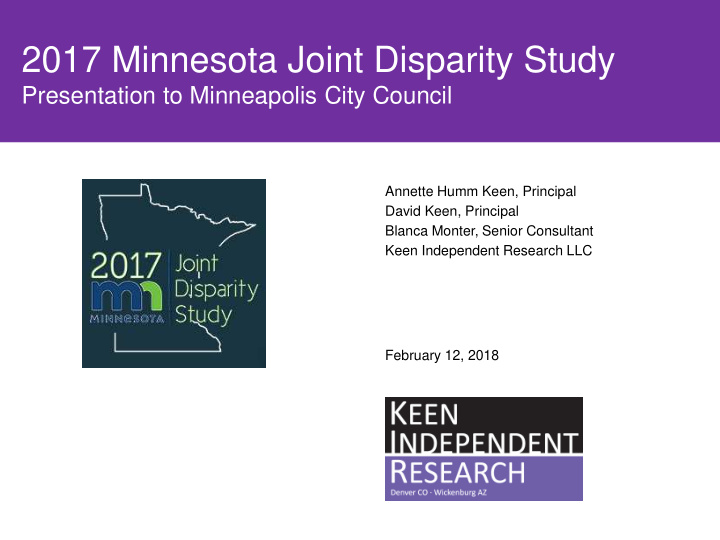



2017 Minnesota Joint Disparity Study Presentation to Minneapolis City Council Annette Humm Keen, Principal David Keen, Principal Blanca Monter, Senior Consultant Keen Independent Research LLC February 12, 2018
Agenda 1. Introductions 2. Why conduct a disparity study? 3. Disparity study tasks 4. Utilization/availability results 5. Results of qualitative analysis 6. Recommendations 2
Why conduct a disparity study? 1989 U.S. Supreme Court decision in City of Richmond v. J.A. Croson Company established the strict scrutiny standard of review for race-conscious programs adopted by state and local governments: Compelling governmental interest Narrow tailoring The disparity study examined whether there is evidence of discrimination against minority- and women-owned firms in the marketplace, and, if so, what remedies might be appropriate Disparity study provides information to help each entity: Determine if current programs, alone, are an effective remedy Whether additional or different measures are needed Also, outside review of policies and practices is useful Study also examined marketplace conditions for businesses owned by persons with disabilities and veterans 3
Quantitative analysis Collected data for the study period (July 1, 2011 through June 30, 2016) Contracts awarded Small purchases Coded primary type of work involved in each contract and subcontract (construction, professional services, goods and other services) Determined relevant geographic market area (Minneapolis-Saint Paul-Bloomington, MN-WI MSA) Calculated percentage of procurement dollars awarded to MBE/WBEs Conducted availability analysis: Availability survey Contract-by-contract availability analysis Performed disparity analysis 4
Example of component of availability analysis Subcontract for excavation ($444,694) on a 2013 City of Minneapolis contract in the Twin Cities area Examined firms that: Were in business in 2013 Indicated that they performed electrical work Reported working or bidding on subcontracts on public sector projects in Minnesota in the past 6 years Reported qualifications and interest in working as a subcontractor on public sector contracts Reported bidding on work of similar or greater size in the past 6 years Reported ability to perform work in the Twin Cities area 92 businesses in the availability database met those criteria and 21 were MBE/WBE, so MBE/WBE availability was 23% (21/92 = 23%) Dollar-weighted result added to availability calculations that included all other City contracts and subcontracts 5
Utilization and availability for City of Minneapolis procurements, July 2011–June 2016 30% 100% 25% MBE/WBE 20% 17.60% 15% 11.17% 10% 5% 0% Utilization Availability 0.176 6
Disparity results for City of Minneapolis procurements, July 2011–June 2016 Disparity Utilization Availability index African American-owned 0.47 % 2.40 % 20 Asian American-owned 0.89 0.95 93 Hispanic American-owned 0.26 0.73 36 Native American-owned 3.56 2.09 170 Unknown MBE 0.02 Total MBE 5.19 % 6.17 % 84 WBE (white women-owned) 5.99 11.42 52 Total MBE/WBE 11.17 % 17.60 % 63 7
Disparity results for City of Minneapolis procurements Utilization exceeding Disparity availability Notes Construction Program applied African American-owned Substantial Asian American-owned No disparity Hispanic American-owned Substantial Native American-owned No disparity WBE (white women-owned) Substantial Total MBE/WBE Small disparity Professional services Program applied African American-owned Substantial Asian American-owned Substantial Hispanic American-owned Substantial Native American-owned Substantial WBE (white women-owned) Substantial Total MBE/WBE Substantial 8
Disparity results for City of Minneapolis procurements Utilization exceeding Disparity availability Notes Goods Program applied African American-owned Substantial Asian American-owned Substantial Hispanic American-owned Substantial Native American-owned Substantial WBE (white women-owned) Substantial Total MBE/WBE Substantial Other services Program applied African American-owned Substantial Asian American-owned No disparity Hispanic American-owned No disparity Native American-owned Substantial WBE (white women-owned) No disparity Total MBE/WBE No disparity 9
Qualitative analysis Conducted in-depth personal interviews and focus groups with 110 businesses and trade associations Performed telephone interviews with thousands of other firms Topics included local marketplace, business assistance programs, contracting and procurement policies Access to capital was a barrier for MBE/WBEs Prompt payment was an issue Business experienced exclusionary practices (“Good ol’ boy” networks) 10
Recommendations Work with participating entities to address barriers and open opportunities for minority- and women-owned firms and other small businesses Based on all information available, consider more broadly implementing existing programs: Ensure that the City is in compliance with MBE outreach requirements in Section 271 of the Affordable Housing Act and HUD guidance Enforce review of professional services contracts above $100,000 by Department of Civil Rights for potential contract goal Periodically update the City’s overall annual goals for MBE and WBE participation, if it chooses to retain them 11
Recommendations (continued) Pursue opportunities for new and better tools to address barriers: Enacting a price and evaluation preference program for prime contractors and vendors similar to State Targeted Group program Requiring certification as SBEs for any participation in the Target Market Program Refining the TMP size limits to better reflect subindustry differences of what constitutes a “small” firm Aligning the geographic area from which firms are eligible for participation in the SUBP and the TMP Creating a specialized prime contractor/prime consultant capacity-building program for specific types of small construction and professional services contracts 12
Public forums 13
Recommend
More recommend